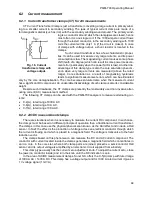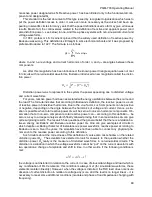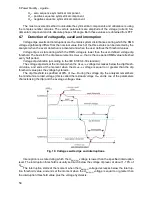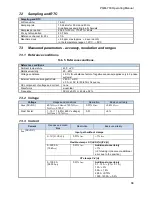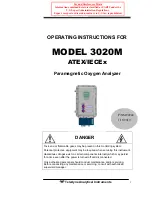
6 Power Quality - a guide
53
The IEEE 1459 standard gives the following formulas. In three-wire systems:
𝐼
𝑒
= √
𝐼
𝑎
2
+ 𝐼
𝑏
2
+ 𝐼
𝑐
2
3
𝑈
𝑒
= √
𝑈
𝑎𝑏
2
+ 𝑈
𝑏𝑐
2
+ 𝑈
𝑐𝑎
2
9
In four-wire systems:
𝐼
𝑒
= √
𝐼
𝑎
2
+ 𝐼
𝑏
2
+ 𝐼
𝑐
2
+ 𝐼
𝑛
2
3
𝑈
𝑒
= √
3(𝑈
𝑎
2
+ 𝑈
𝑏
2
+ 𝑈
𝑐
2
) + 𝑈
𝑎𝑏
2
+ 𝑈
𝑏𝑐
2
+ 𝑈
𝑐𝑎
2
18
where I
a
, I
b
, I
c
, are RMS currents for individual phases (line or phase), I
n
is the RMS current in neutral
conductor, U
a
, U
b
, U
c
are RMS phase-to-neutral voltages, and U
ab
, U
bc
, U
ca
are RMS phase-to-phase
voltages.
S
e
calculated in this manner includes both the power losses in the neutral conductor (in four-
wire systems) and the effect of unbalance.
6.4.6 Distortion power D
B
and effective nonfundamental apparent power S
eN
During the discussion on reactive power, it was proved that the distortion power according to
Budeanu cannot be used at large voltage and current distortions and three-phase systems unbal-
ance (a paradox of distortion power which is not a measure of actual distortion). Despite this fact,
however, this power is often used by energy quality specialists and manufacturers of systems for
reactive power compensation.
It must be clearly said that this parameter has given relatively good results only in conditions of
slight distortion of voltage and current waveforms.
The IEEE 1459-2000 standard lists this definition of power, however just like in case of Budeanu
reactive power, it has a non-removable defect and it is recommended to discard it entirely. Instead
of
D
B
, another value has been proposed which is a much better characteristics of total distortion
power in a system - nonfundamental apparent power
S
eN
. The
S
eN
power allows a quick estimation
whether a load works in conditions of small or large harmonic distortion; it is also a basis for esti-
mating the static values and active filters or compensators.
𝑆
𝑒𝑁
= √𝑆
𝑒
2
− 𝑆
𝑒1
2
where:
𝑆
𝑒1
= 3𝐼
𝑒1
𝑈
𝑒1
Effective current and effective voltage of the fundamental component (
I
ef
and
U
ef
respectively) are
calculated similarly to
I
e
and
U
e
, but instead of RMS phase-to-neutral or phase-to-phase voltages,
the effective voltages of fundamental components are substituted:
𝑆
𝑁
= √𝑆
2
− (𝑈
1
𝐼
1
)
2
Summary of Contents for PQM-700
Page 85: ...85 Notes...






